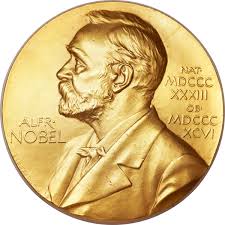
Who has been honoured in the past?
While you will not know all the names, you will know many of them … Rudyard Kipling, W. B. Yeats, George Bernard Shaw, Thomas Mann, T. S. Eliot, William Faulkner, Bertrand Russell, Winston Churchill, Ernest Hemingway, John Steinbeck, Jean-Paul Sartre, Samuel Beckett, Aleksandr Solzhenitsyn, William Golding, Seamus Heaney, Harold Pinter, Doris Lessing.
Have you read anything by even one of them? If not, then why not pick just one and dive in to see what is out there to be discovered.
Let me help with a suggestion, try the 1927 essay “Why I Am Not a Christian” by Bertrand Russell – I’ve put an on-line copy up here for you to read.
So anyway, who has won the prize for literature this year?
The Nobel Prize in Literature 2013
Alice Munro
The Nobel Prize in Literature for 2013 is awarded to the Canadian author Alice Munro
Who?
Alice Munro was born on the 10th of July, 1931 in Wingham, which is in the Canadian province of Ontario. Her mother was a teacher, and her father was a fox farmer. After finishing high school, she began studying journalism and English at the University of Western Ontario, but broke off her studies when she got married in 1951. Together with her husband, she settled in Victoria, British Columbia, where the couple opened a bookstore. Munro started writing stories in her teens, but published her first book-length work in 1968, the story collection Dance of the Happy Shades, which received considerable attention in Canada. She had begun publishing in various magazines from the beginning of the 1950’s. In 1971 she published a collection of stories entitled Lives of Girls and Women, which critics have described as a Bildungsroman.
Munro is primarily known for her short stories and has published many collections over the years. Her works include Who Do You Think You Are? (1978), The Moons of Jupiter (1982), Runaway (2004), The View from Castle Rock(2006) and Too Much Happiness (2009). The collection Hateship, Friendship, Courtship, Loveship, Marriage (2001) became the basis of the film Away from Her from 2006, directed by Sarah Polley. Her most recent collection is Dear Life(2012).
Munro is acclaimed for her finely tuned storytelling, which is characterized by clarity and psychological realism. Some critics consider her a Canadian Chekhov. Her stories are often set in small town environments, where the struggle for a socially acceptable existence often results in strained relationships and moral conflicts – problems that stem from generational differences and colliding life ambitions. Her texts often feature depictions of everyday but decisive events, epiphanies of a kind, that illuminate the surrounding story and let existential questions appear in a flash of lightning.
Her writing style
Many of Munro’s stories are set in Huron County, Ontario. Her strong regional focus is one of the features of her fiction. Another is the omniscient narrator who serves to make sense of the world. Many compare Munro’s small-town settings to writers of the U.S. rural South. Her female characters, though, are more complex. Much of Munro’s work exemplifies the literary genre known as Southern Ontario Gothic.
Munro’s work is often compared with the great short story writers. In Munro stories, as in Chekhov’s, plot is secondary and “little happens.” As with Chekhov, Garan Holcombe notes: “All is based on the epiphanic moment, the sudden enlightenment, the concise, subtle, revelatory detail.” Munro’s work deals with “love and work, and the failings of both. She shares Chekhov’s obsession with time and our much-lamented inability to delay or prevent its relentless movement forward.”
A frequent theme of her work—particularly evident in her early stories—has been the dilemmas of a girl coming of age and coming to terms with her family and the small town she grew up in. In recent work such as Hateship, Friendship, Courtship, Loveship, Marriage (2001) and Runaway (2004) she has shifted her focus to the travails of middle age, of women alone and of the elderly. It is a mark of her style for characters to experience a revelation that sheds light on, and gives meaning to, an event.
Munro’s prose reveals the ambiguities of life: “ironic and serious at the same time,” “mottoes of godliness and honor and flaming bigotry,” “special, useless knowledge,” “tones of shrill and happy outrage,” “the bad taste, the heartlessness, the joy of it.” Her style places the fantastic next to the ordinary with each undercutting the other in ways that simply, and effortlessly, evoke life. As Robert Thacker notes: ”
Munro’s writing creates… an empathetic union among readers, critics most apparent among them. We are drawn to her writing by its verisimilitude – not of mimesis, so-called and… ‘realism’ – but rather the feeling of being itself… of just being a human being.”
Many critics have asserted that Munro’s stories often have the emotional and literary depth of novels. The question of whether Munro actually writes short-stories or novels has often been asked. Alex Keegan, writing in Eclectica, has a simple answer: “Who cares? In most Munro stories there is as much as in many novels.”
I suspect for many it will now be time to go hit the Kindle store – here is her latest book.